
Freesia is a genus of herbaceous perennial flowering plants in the family Iridaceae, first described as a genus in 1866 by Christian Friedrich Ecklon (1886) and named after the German botanist and medical practitioner, Friedrich Freese (1795-1876). It is native to the eastern side of southern Africa, from Kenya south to South Africa, most species being found in Cape Provinces. Species of the former genus Anomatheca are now included in Freesia. The plants commonly known as "freesias", with fragrant funnel-shaped flowers, are cultivated hybrids of a number of Freesia species. Some other species are also grown as ornamental plants.

Iridaceae is a family of plants in order Asparagales, taking its name from the irises, meaning rainbow, referring to its many colours. There are 66 accepted genera with a total of c. 2244 species worldwide. It includes a number of other well known cultivated plants, such as freesias, gladioli and crocuses.
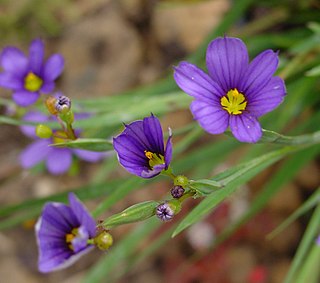
Sisyrinchium is a large genus of annual to perennial flowering plant in the family Iridaceae. Native to the New World, the species are known as blue-eyed grasses and, though not true grasses and in varieties with flower colors other than blue, are monocots.

Dietes is a genus of rhizomatous plants of the family Iridaceae, first described as a genus in 1866. Common names include wood iris, fortnight lily, African iris, Japanese iris and butterfly iris, each of which may be used differently in different regions for one or more of the six species within the genus.

Dierama is a genus of flowering plants in the family Iridaceae. Common names include hairbells, angel's fishing rod, fairybells, and wandflowers in English and grasklokkies in Afrikaans. They are native to Africa, with most occurring in the southern regions of the continent. The center of diversity is the province of KwaZulu-Natal in eastern South Africa.
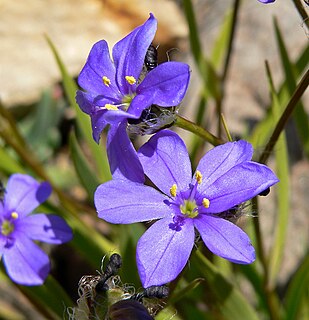
Aristea is a genus of evergreen, perennial and rhizomatous species of flowering plants in the family Iridaceae, first described in 1789. The genus is distributed in tropical and southern Africa, as well as Madagascar. The genus name is derived from the Greek word arista, meaning "awn".

Crocoideae is one of the major subfamilies in the family Iridaceae.
Cyanixia is a genus of plants in the Iridaceae, first described in 2003. It contains only one known species, Cyanixia socotrana, a perennial, herbaceous and bulbous plant species endemic to the Island of Socotra in the Indian Ocean, part of the Republic of Yemen.
Devia is a genus of plants in the family Iridaceae first described in 1990. It contains only one known species, Devia xeromorpha, endemic to the southwestern part of Cape Province in South Africa. The genus was named in honour of the South African botanist and academic, Miriam Phoebe de Vos.
Xenoscapa is a genus of herbaceous, perennial and bulbous plants in the family Iridaceae. It consists of only two species distributed in Africa, and is closely related to the genera Freesia. The genus name is derived from the Greek words xenos, meaning "strange", and scapa, meaning "flowering stem".

Klattia is a genus of flowering plants in the family Iridaceae first described as a genus in 1877. The entire genus is endemic to Cape Province in South Africa. The genus name is a tribute to the German botanist Friedrich Wilhelm Klatt, who significantly advanced the body of knowledge of the family Iridaceae in the 19th century.

Melasphaerula is a genus of flowering plants in the family Iridaceae, first described as a genus in 1803. There is only one known species, Melasphaerula graminea, native to Namibia and the Cape Province in South Africa.
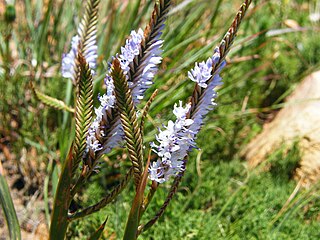
Micranthus is a genus of flowering plants in the family Iridaceae. The entire genus is endemic to Cape Province in South Africa.
Radinosiphon is a genus of flowering plants in the family Iridaceae first described as a genus in 1932. It is native to southern + southeastern Africa.
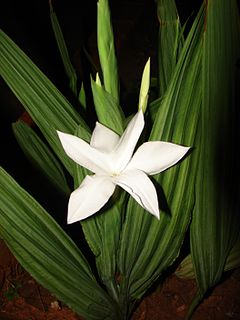
Savannosiphon is a genus of flowering plants in the family Iridaceae, first described as a new species in 1980. It contains only one known species, Savannosiphon euryphylla, native to tropical Africa.
Thereianthus is a genus of flowering plants in the family Iridaceae, first described as a genus in 1941. The entire genus is endemic to Cape Province in South Africa.

Trimezia is a genus of flowering plants in the family Iridaceae, native to the warmer parts of southern Mexico, Central America, South America, Florida, and the West Indies. Trimezia is placed in the tribe Trimezieae. The division of the tribe into genera has varied considerably. In one approach, it contains only the genus Trimezia, which then includes the genera Neomarica, Pseudotrimezia and Pseudiris. In other approaches, two to five genera are recognized, sometimes also including the genus Deluciris.
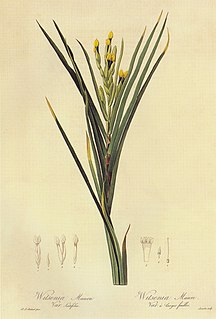
Witsenia is a genus of flowering plants in the family Iridaceae, first described as a genus in 1782. There is only one known species, Witsenia marua, endemic to Cape Province in western South Africa.

Babiana ambigua is a species of plant in the Iridaceae. It is endemic to Cape Province in South Africa.
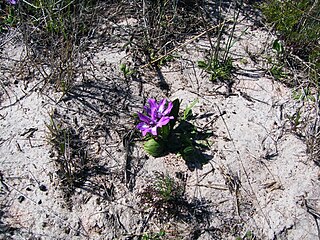
Babiana nana, the sandflat baboon-root, is a species of plants in the family Iridaceae. It is endemic to Cape Province of South Africa, and naturalized in Western Australia.
- Babiana nana subsp. maculata(Klatt) Goldblatt & J.C.Manning
- Babiana nana subsp. nana















